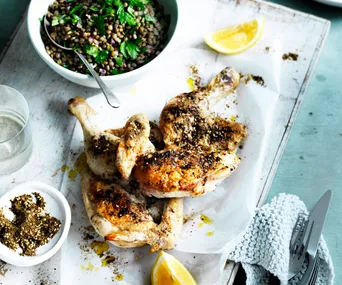As versatile as chicken is, many of us tend to play it safe and pick the cut that we’re most familiar with when cooking. While you won’t get any arguments from us that a tender poached chicken breast is a great addition to a crisp summer salad, there’s a time and a place for chicken tenderloins, chicken thighs and chicken liver too. Below, we break down what you need to know about each cut of chicken.
Chicken breast
One of the most-used cuts, chicken breast is low in fat and rich in protein. You can pan-fry, poach, sauté, roast and barbecue a chicken breast, making it a good all-rounder, whatever type of dish you’re cooking.
It’s the leanest part of the bird so be wary of overcooking — a dry chicken breast is not pleasant. If you’re in a rush, avoid turning up the heat. Instead, butterflying the breast will ensure the flesh cooks quickly and evenly. You can ask your butcher to do it for you or use a sharp knife to cut through the raw breast length-wise ensuring the flesh is still joined on one side.
Cook the breast as is or crumb, stuff or marinate it. Skin on or off is a matter of personal preference.
Chicken thighs
Chicken thighs can be bought as fillets, with the skin and bone removed, or cutlets with bones and skin intact. Is that the only difference? Without the skin and fat layer protecting the fillet, the meat retains less moisture when cooked, so for cooking without additional fat or moisture, it’s best to go for the whole thighs. Boneless thighs will also require less cooking time.
This part of the bird is darker and fattier than the breast as it’s a working cut, and therefore has a lot more flavour. It’s favoured for roasts, curries and casseroles to utilise that rich, full flavour.
Thigh fillets are ideal for chicken skewers. The extra intramuscular fat in thighs adds extra richness to the meat. If it’s amplified flavour you seek, add spice to the fillets prior to cooking.
If you come across the term chicken marylands, this refers to chicken thighs with the leg (or drumstick) attached. Give them a go in this Persian chicken dish — one of our most clicked-on recipes.
Chicken legs
Easy to cook, chicken legs or drumsticks are ideal for casual entertaining. This cut of meat is from the bird’s thigh and is made for barbecuing, however you can oven-roast or braise them also.
As much as chicken drumsticks are billed as finger food, they can still impress guests at a sit-down dinner. Try these roasted drumsticks with olives and capers; a relatively quick dish with minimum fuss.
While you can cook and serve these plain, a sticky barbecue sauce is recommended to deliver a memorable taste. Stuck for ideas? Try these fried buttermilk drumsticks. They’re always a crowd-pleaser.

The perfect summer entertaining dish: Pernod-roasted chicken with nectarine, barley and fennel salad
Chicken wings
Like drumsticks, wings can be glazed and served whole or separated into two — wingettes and drumettes (the meatier upper portion). Chicken wings are an excellent all-rounder and are best barbecued or grilled.
Chicken liver
You can buy chicken livers from your butcher separately — teamed with sherry, they make a rich and moreish (if slightly indulgent) canapé.
Best used fresh, they can be soaked in milk overnight, which helps to remove some of the bitterness and excess blood before cooking.
When it comes to cooking with chicken livers, a chicken liver parfait and chicken liver and foie gras pâté are obvious choices. Or, for something different, pair them with pancetta and toasted fregola.
Whole chicken
Whether stuffed, poached or seasoned with herbs and spices and roasted, if you have the time and need to cater for a large group then cooking a whole chicken is the best option.
Roasting is a traditional and flavour-filled choice. There are myriad ways to work with roast chicken, but you can also poach or braise your bird to lock in succulent flavours and deliver melt-in-the-mouth texture.
If you decide to break the chicken down into separate cuts, also known as jointing a chicken, make sure you keep the carcass to make your own gravy, stock or soup.
That’s the golden rule: don’t throw anything out. Almost every aspect of a chicken can be used for something, which is why this humble bird is one of our favourite ingredients to cook with.
 Anson Smart
Anson Smart

